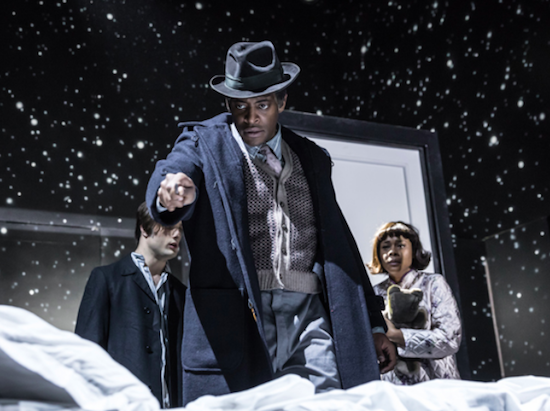Running for five seasons, from October 1959 to June 1964, Rod Serling’s The Twilight Zone was the original science-fiction-psychological-supernatural-suspense anthology show, more than 50 years before Black Mirror began. Manifold references to Serling’s original vision abound in popular culture – in Futurama episodes, songs by The Fall (‘Time Enough At Last’) and the Melvins (‘The Brain Centre At Whipple’s’), films such as Airplane and E.T. – and Marius Constant’s ‘Twilight Zone’ theme music has long since become the standard-bearing melody of the eerie and inexplicable. Even among individuals who have never seen it, the programme represents an ingrained phantasmagorical strata of the American cultural subconscious.
Appropriately enough, the task of revisiting the show for the purposes of the modern stage, has been undertaken by playwright Anne Washburn, whose previous work, Mr Burns, attempted a similar dissection of the iconography of an equally quintessential American TV show, The Simpsons. Using masterful sound manipulation from composer and theremin player Sarah Angliss and innovative set design from Paul Steinberg, focusing squarely on the show’s trademark black-and-white starry-sky look, the play weaves together eight episodes from original scripts by Rod Serling, Charles Beaumont and Richard Matheson. Washburn reportedly watched every one of the show’s original 156 episodes back-to-back before paring it all down with theatre director Richard Jones.
There has been some criticism of the play’s conflict between The Twilight Zone’s satirical and moralising aspects. In fact, though, the friction between these two impulses, always present in Serling’s writing and his often ostentatious introductions, serves to underscore the difference between how far society has come since the late 50s and how little it has progressed.
Opening with Serling’s ‘Will The Real Martian Please Stand Up’, the play sets out its stall in familiarly hokey-endearing territory, with a policeman in search of the alien invader hidden among the patrons of a diner. As a wide-eyed eccentric customer notes, it’s: “Just like a science fiction is what it is. A regular Ray Bradbury.” Of course, it only takes the suggestion that a stranger is among them to turn people against one another. Washburn keeps the audience on their toes, electing to fragment this and the seven other chosen episodes and have set changes out in the open; stagehands are dressed in black and dotted with the same stars that decorate the background. ‘And When The Sky Was Opened’, ‘Little Girl Lost’, ‘Nightmare As A Child’ and ‘Perchance To Dream’ more or less faithfully translate the uncanny ambience of the original episodes. ‘The Long Morrow’, in which an astronaut falls in love on the eve of a 40-year-long space voyage, is poignant and also stresses how the speed of innovation may be overtaking the personal sacrifices once deemed necessary.
‘The Eye Of The Beholder’, present only in embryonic form, seems even more relevant today than when it first aired in 1960. A young woman’s facial bandages are removed to reveal the results of her plastic surgery, and her beauty is matched by the attendant health professionals’ hideous faces, while on the television their leader rails about “glorious conformity.” The most emotionally hard-hitting section of the play, based on the 1961 episode ‘The Shelter’, is drenched in cold war paranoia but also reflects a number of unpleasant present-day neuroses. A group of neighbours host a dinner for the local doctor; when a public service announcement heralds the arrival of some unknown objects, presumably missiles, heading towards the US, the group’s social niceties dissolve as they jostle for a place in the doctor’s shelter. By the time it has become apparent that the objects in question are merely satellites, the characters have almost annihilated themselves. (Quite possibly, if Rod Serling were alive today, his take on the nuclear bunker would take a different turn, reflecting a modern day development – the supply of nuclear bunkers for the super-rich.)
Sadly, perhaps the most enduringly pertinent of Serling’s Twilight Zone episodes, 1960’s ‘The Monsters Are Due On Maple Street’, is absent from Washburn’s play. Aliens plant the suggestion, sustained with a few simple parlour tricks, that an imposter is living among the residents of a suburban American street. The neighbours then proceed to tear the fragile fabric of their society apart, while the aliens are revealed at the end, saying: “This Maple Street is not unique… Their world is full of Maple Streets. And we’ll go from one to another and let them destroy themselves.”
The Twilight Zone runs at the Almeida until Saturday 27 January


